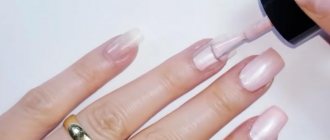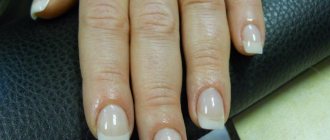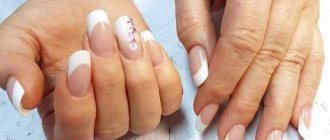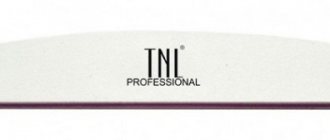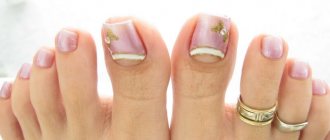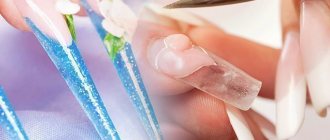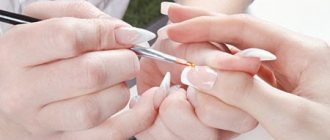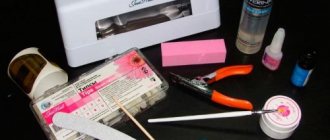Nail extensions are one of the most popular nail salon services, which solves the problem of a perfect manicure for the modern woman. But for some reason, some masters recommend only gel, while others definitely recommend acrylic. Where is the truth? Let’s try to understand the intricacies of gel and acrylic nail extensions and answer the question: “Which material is better: gel or acrylic?”
What is more harmful: gel or acrylic?
More often than others, you can come across the opinion that acrylic is harmful to nails, as it has a more “nuclear” composition. This is nothing more than a myth. You need to know that both gel and acrylic are acrylates, that is, they have a similar chemical composition and affect the nail plate in approximately the same way. However, there are known cases of allergies to both materials. Neither gel nor acrylic extensions will make your own nails healthier and stronger; moreover, after either of these two procedures they will require restoration. Therefore, none of the materials being compared is more beneficial or harmful than the other.
How to choose?
The best way to decide which nail extension is best is to try both methods. Some fashionistas can only wear gel nail extensions, while for others this material is not suitable at all (it often cracks, breaks, peels off). There are cases (about seven percent) when the nail plates do not accept artificial coating and reject any material.
According to experts, the appearance of cracks, breaks and other problems with false nails may be caused not only by low-quality material, but also by the unprofessional work of the master, non-compliance with operating rules, and individual intolerance to the material. Also, artificial material can peel off due to fungus or other skin diseases, taking antibiotics, hormonal imbalances (during pregnancy or problems with the endocrine system).
What is the difference between acrylic and gel?
Nail extension gel is a fluid substance that looks like polish and spreads over the nail much like regular nail polish. Gels are either photosensitive (harden when exposed to UV rays) or non-photosensitive (requires a catalyst to harden). You can also find single-phase, two-phase and three-phase extension gels. The gel has no odor, which is its huge advantage.
With acrylic everything is both simpler and more difficult at the same time. Acrylic is a powder that, when mixed with a special liquid (liquid, monomer), turns into a thick plastic substance that quickly hardens in air. Acrylic does not flow and does not require any special means for hardening. But they need to work quickly, as it hardens within a few minutes. The big disadvantage of acrylic is the strong “dental” smell of the liquid.
The difference between gel and acrylic is described in great detail in the video:
Nail extension with gel and acrylic: technology features
Both gel and acrylic can be applied to natural nails, and can also be used for extensions on tips or forms. Many people believe that acrylic extensions are longer and more complex, but objectively both procedures last approximately the same and contain a similar set of steps.
For both types of extensions, the procedure consists of three steps:
- Preparing the nail plate and applying primer (bonder).
- The actual application of the modeling material.
- Applying the finishing coat.
The first and third stages of extensions with gel or acrylic are almost the same, the difference is noticeable only at the second stage and it is associated with the peculiarities of the “behavior” of the gel or acrylic.
The gel is applied to the nail with a brush, like varnish, and then cured using a UV lamp or catalyst. If an error occurs when applying the gel (flowing behind the cuticle, etc.), after hardening it can only be eliminated by filing it down; in serious cases, the nail will have to be completely redone.
Photo: lucina.ru
Unlike gel, the acrylic composition must first be “cooked”. The brush is dipped in liquid, then in acrylic powder, as a result a ball is formed at the tip of the brush, which must be carefully transferred to the nail and quickly distributed. An already hardened coating can be easily corrected using a special acrylic softening composition. The acrylic coating is absolutely impenetrable, so fungus can grow under it during wear. To prevent this from happening, nails are treated with an antifungal compound before applying acrylic.
Factors to consider
Before performing extensions, you should pay attention to the product that will better play the role of a basis for artificially lengthening the free edge of the nails, since your convenience and the final result will depend on it.
Also, first make sure of the quality of the selected composition so that it is better distributed over the nails and lies evenly.
Key factors to consider when choosing between gel and acrylic powder:
- Safety. Acrylic powder often contains formaldehyde or its derivatives, which is very dangerous for a girl’s body. Despite the fact that hypoallergenic acrylic has increasingly begun to be produced, it can still negatively affect the quality of natural nails. The gel base is absolutely safe for natural manicure even when worn for more than 3-4 weeks;
- Wear resistance. Acrylic powder is plexiglass that has a dense structure, so even mechanical impact on the free edge cannot lead to its breakage in most cases. The gel has a more porous structure, which is why it is better to use it for long-term wear, since it creates a semblance of a natural plate without loading it;
- Price. Both compositions have approximately the same price, even if you use them when performing nail correction at home. However, keep in mind that the correction of acrylic manicure is most often carried out partially, which is why the price of the technology is reduced by 1.5-2 times;
- Flexibility. An individual parameter, therefore, only the girl herself can decide what is best. Acrylic, due to its density and wear resistance, practically does not bend; the same cannot be said about the gel substrate. Its flexibility is more reminiscent of a natural nail bed, so it is more likely to break;
- Long-term preservation. The frequency of corrections also depends on the quality of the material used, however, for long-term wear, it is better to use an acrylic decorative coating, since it can be changed every month. The gel should be renewed once every 2.5-3 weeks, otherwise it will begin to break off, form cracks, and chips;
- Smell. The main criterion that must be taken into account regarding health-related contraindications to the procedure. Acrylic during application and polymerization has a rather bright, toxic odor, therefore, unlike gel, it is better not to use it during pregnancy or if you have a respiratory tract disease;
- Effect on nails. Despite the fact that most compositions are now hypoallergenic and cannot cause an allergic reaction, it is better to periodically take a break from growing nails. Acrylic can create a favorable environment for pathogenic microflora, and the gel disrupts the water balance of the matrix, drying it out. Because of this, regardless of the type of foundation used, proper hand care must be ensured.
In terms of time, both products are applied approximately the same. Despite the fact that acrylic powder must first be diluted with liquid, it often has self-leveling properties.
Due to its thick consistency, the gel takes a long time to spread, turning your fingers face down 1-2 times.
Also keep in mind that acrylic powder, despite its wear resistance, is sensitive to high humidity. Because of this, if you often come into contact with water (for example, if this is related to professional activities) and do not use protective gloves, it is better to choose a gel for treating nails. This recommendation also applies to athletes, since sweating also creates a humid environment.
Nail appearance: which is better - gel or acrylic?
The undeniable advantage of gel extensions is that it gives a shiny and perfectly even coating, allowing your nails to always look well-groomed. As a result of using acrylic, the layer turns out matte, and to add shine, the nail must be additionally coated with varnish. But acrylic has a significant advantage: such a coating, matched to the tone of the natural nail, makes the extended nails very natural and almost indistinguishable from real ones.
Both gel and acrylic provide a lot of space for realizing the most daring nail design ideas:
- Modeling. For gel sculpting, only special 3D gels are used; the usual ones are too liquid for this purpose. The thicker and more flexible acrylic mass is simply an ideal material for sculpting. Modeling with acrylic gives the most amazing results that gel is not capable of.
- “Aquarium” nail design is the arrangement of decorations under a transparent layer, giving the image a voluminous effect. With both types of extensions, glitter, sand, rhinestones, dried flowers, foil or fimo figures, as well as bas-reliefs (convex designs) can be placed under a layer of transparent gel. The advantage of acrylic here is the wide possibilities of three-dimensional modeling; gel has an amazing gloss, reminiscent of liquid glass.
- French. The popular French manicure is done with both gel and acrylic, but girls who have tried both methods claim that the acrylic French manicure is more natural, neat and airy. However, a good master’s gel jacket comes out very beautiful, so it’s a matter of taste.
Features of gel and acrylic socks
The gel is similar in elasticity to a natural nail and bends with it. It can be varnished on top and treated with liquid with acetone without fear for its safety. In general, it is less capricious to wear than acrylic, and has only one real weak point - low temperatures (gel cracks from frost and sudden temperature changes). At the same time, it is more susceptible to breakage than acrylic.
Acrylic is considered a stronger and more flexible nail coating and, compared to gel manicures, breaks much less often. The disadvantages of wearing acrylic include:
- dullness of the coating - to achieve shine, you need to cover your nails with transparent varnish yourself or order additional nail polish for extensions and corrections, which increases the final cost of the work;
- color change - acrylic can turn yellow under the influence of various chemicals, for example, regular nail polish or household chemicals;
- Do not use nail polish removers with acetone - the coating may crack.
Of course, when extending using both methods, nails must be protected from excessive mechanical stress. However, it has been noticed that with gel extensions, it is the extended (artificial) part that breaks without damaging the regrown natural nail, while with acrylic extensions, your own nail often breaks, which is much more painful and offensive.
Modeling or strengthening?
Today, salons offer two main ways to strengthen nails - gel polish and biogel. What are they good for?
Advantages of strengthening compared to extension (modeling):
• the procedure does not involve filing, or it is minimal, which means minimal damage to the nail plate;
• less time is spent on manicure (for comparison: extension lasts about 2 hours, strengthening – 40-60 minutes);
• the strengthening option is ideal if you need to get your nails in order once (for some celebration). In this case, extensions are not recommended due to unnecessary injury to the plate (extensions are more suitable for long-term wear);
• nails look more natural than artificial ones;
• you can grow your nails long, since under the coating they do not break or peel.
Disadvantages of strengthening compared to extensions:
• more frequent trips to the salon (every two weeks, while extended nails last about a month);
• accordingly, a repeated strengthening procedure will be more expensive than correction of extended nails: you need to do a manicure, remove the material, apply a new one (thus, you pay for three procedures);
• it is not possible to simulate the length of the nail, because the material lies strictly on your nail;
• gel polish and biogel remover is very drying to the skin around the nail (you need to use cuticle cream or oil).
Correction of gel and acrylic nails
The concept of correction includes applying a modeling agent (gel or acrylic) to the regrown part of the nail plate, applying a new layer to the entire nail in order to hide scratches and minor damage, and repairing peeled and chipped areas of the artificial coating.
The frequency of correction does not depend on the extension material (gel or acrylic), but on the growth rate of your own nails. It is usually done every 2-4 weeks. Correction technologies with gel and acrylic are very similar; the difference, as in the case of extensions, is only in the features of the coating itself. But there is an important difference: a damaged gel nail needs to be completely redone. Acrylic nails can be “repaired” without removing the extensions, which is much faster (it’s a pity that it’s not cheaper).
How to extend nails with acrylic?
Acrylic nail extension lessons take place in several stages:
- prepare the nail - disinfect, remove the cuticle, polish the nail plate for better adhesion of the material, degrease and apply a primer that removes excess liquid;
- a special form is put on the nail or a tip is glued; acrylic can be applied to both;
- a special brush is dipped into the monomer, then into acrylic powder, the resulting ball is evenly distributed over the nail and its appearance is modeled;
- when the coating has dried, the craftsman begins to cut out the final shape with files of different roughness and create a design;
- at the end everything is covered with finishing gel to make the nails shine.
Removing gel and acrylic
A significant disadvantage of the gel coating is that when removing extended nails, the gel from the nail must be filed away for a long time and tediously. During sawing, a lot of fine dust is produced (cases of allergies to this dust are known). It is strictly not recommended to remove gel nails at home - there is a very high risk of damaging your nails.
Removing acrylic is more “civilized” - just hold the nails in a special solution, after which the acrylic softens and is easy to remove with a spatula. You can do this procedure yourself by purchasing the required solution in the store. Unfortunately, in both cases, your own nails need to be restored after removal.
Difference in prices for nail extensions with gel and acrylic
Acrylic extensions are still less popular in Russian salons than gel ones; good “acrylic masters” are worth their weight in gold. Therefore, prices for acrylic are often inflated, which is absolutely unjustified from the point of view of the costs of both procedures. In serious salons, prices for acrylic and gel extensions are gradually leveling out, and now they are almost the same:
- extensions under varnish – 2000-3000 rubles,
- extensions with an extension of more than 3 mm - from 3000 rubles,
- French - 2700-3800 TR,
- coverage without extension – 1000-1300 RUR,
- correction - from 50 to 80% of the cost of extensions,
- alteration of one nail – 10% of the cost of extension,
- design – from 70 rub. for the nail,
- modeling – 50-150 rub. per nail.
Prices for withdrawal are more varied and range from 500 to 1300 rubles. for the entire procedure.
Cons of acrylic
Like any material for manicure, acrylic also has its disadvantages. First of all, it is almost impossible to use this material for extensions under varnish. This is due to the fact that it fades after exposure to acetone-containing nail polish remover. There are also a few other minor drawbacks.
The unpleasant odor that accompanies the extension procedure may cause some discomfort for people with a sensitive sense of smell. However, with good air extraction or constant ventilation, this drawback can be eliminated. The smell from nails disappears a few hours after extensions.
When it comes to deciding which nails are best for people with allergies, acrylic or gel, you should definitely choose gel. People prone to contact dermatitis may experience a reaction to the material in places where it comes into contact with the skin. In any case, before applying acrylic extensions, it is recommended to test for an allergic reaction.
https://youtu.be/UTwqJcNckMU

